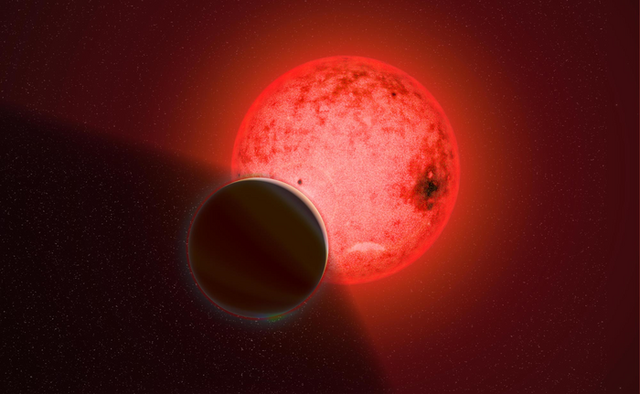A planet the same size as Jupiter has been found around a surprisingly small red dwarf star about 285 light-years from our solar system.
Image Credits: Artist’s conception of a large gas giant planet orbiting a small red dwarf star called TOI-5205. Until now no gas giant has been found in a planetary system around a low-mass M dwarf like TOI-5205 IMAGE BY KATHERINE CAIN, COURTESY OF THE CARNEGIE INSTITUTION FOR SCIENCE.
The gas giant is so large, relative to its host star, that it threatens to up-end long-held theories about how giant planets form.

Planets like TOI 5205b‚ whose discovery in the constellation of Vulpecula is published in The Astronomical Journal, aren’t supposed to exist around small low-mass red dwarf stars like this one.
It was thought that for a Jupiter-sized planet to emerge required rocky material equivalent to 10 planet Earths for the initial core to form.
“The host star, TOI-5205, is just about four times the size of Jupiter, yet it has somehow managed to form a Jupiter-sized planet, which is quite surprising,” said Shubham Kanodia, lead author, from the Carnegie Earth & Planets Lab, in a statement. “Based on our nominal current understanding of planet formation, TOI-5205b should not exist—it is a ‘forbidden’ planet.”
.jpg)
A Jupiter-like planet orbiting a Sun-like star could be compared to a pea going around a grapefruit; for TOI-5205b, because the host star is so much smaller, it is more like a pea going around a lemon, said lead author Shubham Kanodia. IMAGE BY KATHERINE CAIN, COURTESY OF THE CARNEGIE INSTITUTION FOR SCIENCE.
He described TOI-5205b’s orbit of its host stars as a “pea going around a lemon” as opposed to Jupiter’s orbit of the Sun, which is like a “pea going around a grapefruit.”
TOI-5205b was discovered in data from NASA’s alien planet-hunting Transiting Exoplanet Survey Satellite (TESS). TESS finds planets using the transit method. Whenever a planet passes in front of its parent star, that star’s brightness slightly dips. By taking measurements of the light curve the presence of a planet can be inferred.

With TOI-5205b, that was never in doubt because it blocks a whopping seven percent of its host star’s brightness.
That deep dip is crucial because it makes TOI-5205b fertile ground for observations by the James Webb Space Telescope (JWST), which could study its atmosphere and help astronomers better understand how its weirdly giant planet formed.
Source: amazingastronomy.thespaceacademy.org








